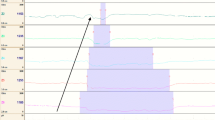Abstract
Background: Multichannel intraluminal-impedance (MII)—pH recording is used frequently for the diagnosis of gastroesophageal reflux disease in children. The location of the pH-sensor is essential to obtain a reliable recording. Positioning of the electrode through radiologic control is recommended as standard. In order to decrease radiation, different attempts have been made to develop equations to obtain a correct positioning of the probe without radiation.
Methods: We prospectively compared the location of the pH-sensor in 212 children according to a formula developed by our nurses (“distance (nose tip to ear canal) + (nose tip with head in neutral position to nipple line) in cm”) to the location determined by fluoroscopy at the seventh posterior rib, which is considered the gold standard. The probe was considered malpositioned if the distance of the formula differed more than 1 cm compared to fluoroscopic control. Statistical analyses were done using R version 4.0.3. Spearman correlation coefficients, mean error and 95% limits of agreement of Bland–Altman plots were calculated. A p-value of <0.05 was considered statistically significant.
Results: According to the overall results, the spearman correlation between the formula and fluoroscopic control was excellent (ρ = 0.91). In 67% of the patients, the location according to the formula was correct, if a difference of 1 cm above or below the exact location is accepted.
Conclusions: The formula adequately predicts the location of the MII-pH probe in 67% of the children (exact distance ±1 cm). In 9% of the children the difference was over 2 cm. Each center should decide: accept about 10% of dislocations of the pH-sensor of 2 cm or more or continue with the radiologic control.
Access this chapter
Tax calculation will be finalised at checkout
Purchases are for personal use only
Similar content being viewed by others
References
Rosen R, Vandenplas Y, Singendonk M, Cabana M, DiLorenzo C, Gottrand F, et al. Pediatric Gastroesophageal reflux clinical practice guidelines: joint recommendations of the North American Society for Pediatric Gastroenterology, Hepatology, and Nutrition and the European Society for Pediatric Gastroenterology, Hepatology, and Nutrition. J Pediatr Gastroenterol Nutr. 2018;66:516–54.
Strobel CT, Byrne WJ, Ament ME, Euler AR. Correlation of esophageal lengths in children with height: application to the Tuttle test without prior esophageal manometry. J Pediatr. 1979;94:81–4.
Moreau B, Kambites S, Lévesque D. Esophageal length: esophageal manometry remains superior to mathematical equations. J Pediatr Gastroenterol Nutr. 2013;57:236–9.
Staiano A, Clouse RE. Value of subject height in predicting lower esophageal sphincter location. Am J Dis Child. 1991;145:1424–7.
Molina A, Villar ME, Pérez A, Ayuso L, Hernández S, Goñi C. Placement of pH-monitoring probes using height-related formulas. Is it an applicable method to adults? Gastroenterol Hepatol. 2016;39:261–4.
Mutalib M, Sintusek P, Punpanich D, Thapar N, Lindley K. A new method to estimate catheter length for esophageal multichannel intraluminal impedance monitoring in children. Neurogastroenterol Motil. 2015;27:728–33.
Nowak J, Jonczyk-Potoczna K, Adamczak D, Lisowska A, Walkowiak J. Esophageal pH monitoring in children: a simple mathematical formula for pH probe positioning. J Pediatr Gastroenterol Nutr. 2015;61:212–4.
Schwend RM, Schmidt JA, Reigrut JL, Blakemore LC, Akbarnia BA. Patterns of rib growth in the human child. Spine Defomrity. 2015;3:297–302.
Author information
Authors and Affiliations
Corresponding author
Editor information
Editors and Affiliations
Rights and permissions
Copyright information
© 2022 The Author(s), under exclusive license to Springer Nature Switzerland AG
About this chapter
Cite this chapter
Vandenplas, Y., Van De Maele, K., Ernst, C., Leus, A., Huysentruyt, K. (2022). How to Position pH-Impedance Probes in Pediatric Patients. In: Vandenplas, Y. (eds) Gastroesophageal Reflux in Children. Springer, Cham. https://doi.org/10.1007/978-3-030-99067-1_18
Download citation
DOI: https://doi.org/10.1007/978-3-030-99067-1_18
Published:
Publisher Name: Springer, Cham
Print ISBN: 978-3-030-99066-4
Online ISBN: 978-3-030-99067-1
eBook Packages: MedicineMedicine (R0)




